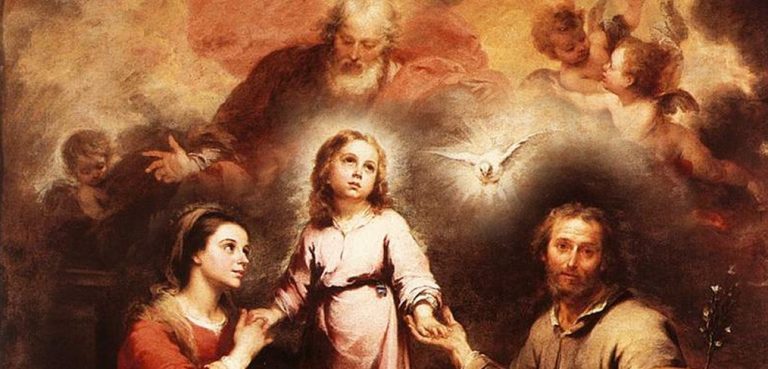By Patrick Coffin

Many people feel it’s impossible, even pointless, to try to understand the Trinity. They feel it’s either an unsolvable puzzle, like a square circle, or an abstraction up in the clouds somewhere. For others, it’s an article of faith, and that’s enough for them. “It’s a mystery,” they shrug, and turn back to the football game. But we were made to understand the Trinity. If we’re going to spend eternity with God—and Gods says He is a Trinity—it’s a good idea to learn as much as possible about what that means. If you were on a bus to Florence, wouldn’t your visit be more enjoyable in proportion to how much you learned about art?
They mystery of the Trinity embraces every other mystery of our faith: our creation, our identity in Christ, and our final destiny in heaven. It’s the tantalizing secret God couldn’t keep to Himself (Rom 16:25, 26), which in the fullness of time, He sent His Son to reveal (Gal 4:4).
The early Church formulated the Trinitarian dogma, fittingly enough, over the course of the three Ecumenical Councils, Nicea (325), Ephesus (431), and Chalcedon (451). The dogma may be summarized by saying that God is one divine nature (His whatness) which belongs to three divine Persons (His whoness). The Father is God, the Son is God, and the Holy Spirit is God; and none of the Persons is any of the other. One God, not three Gods. The First Person, the Father, we designate as Creator; the Second Person, the Son, we designate as the Redeemer; and the Third Person, the Holy Spirit, we designate as the Sanctifier. O, the Father above; the Son beside; the Spirit within.
While Christians, like Jews and Muslims, believe strictly in one God, this one God drops a hint early on about some kind of plurality within Himself. After creating the world and everything in it, God suddenly uses the first person plural when creating man. “Let us make man in our image, after our likeness” (Gen 1:26). This idea is repeated when sin enters the Garden. “Behold, the man has become like one of us, knowing good and evil” (Gen 3:22).
Us? Our? With the coming of Christ and the New Testament witness to the divinity of the Holy Spirit, these murky hints of more-than-oneness were brought to full clarity.
The Father loves the Son infinitely; the Son loves the Father infinitely in return. The infinite love of Father for Son, and Son for Father, “breathes” (spirates) a third infinite love, which is the Holy Spirit. According to the Catechism, “The Church confesses, following the New Testament, ‘one God and Father from whom all things are, and one Lord Jesus Christ, through whom all things are, and one Holy Spirit in whom all things are” (CCC 258, emphases mine).
That’s the Trinity in a nutshell. It’s the Big Idea of Christianity: not a picture to be imagined but a truth to be known, three Persons to be loved. (Religious works of art depicting the Trinity, despite noble and luminous beauty, haven’t exactly done the inquiring mind a big favor. For only the Son is “representable” in visual form; the Father and the Holy Spirit are by definition formless and invisible. If all you learned about the Trinity was gleaned from stained glass depictions, you probably think the Father is an old guy with a long beard, the Son a young guy with a short beard, and the Spirit some kind of white bird in flight.)
So what does any of this have to do with contraception, let alone condemning it? The answer has two facets, both of which bear upon our vocation to imitate, not just the triune God, but also the Word made flesh, Jesus Christ, especially in His supreme example of self-emptying. Call it an application of the natural law in Trinitarian attire.
This God wants us not just to imitate Him; He wants us! And He has a nature far above ours to share with us. “As he who called you is holy,” writes St. Peter, “be holy yourselves in all your conduct; since it is written, ‘You shall be holy, for I am holy’” (1 Pet 1:15, 16). Jesus, the image of the invisible God (Col 1:15), introduced this idea by commanding us to do something that, on first blush, seems impossible: “Be perfect, as your heavenly Father is perfect” (Matt 5:48). Of our own feeble resources, obviously, we can do no such thing. Jesus asks us to do our best, but more importantly, as the Offertory at Mass hints, to let Him do His best in us: “By the mystery of this water and wine may we come to share in the divinity of Christ, who humbled Himself to share in our humanity.”
Biological fecundity is the physical echo of God’s superabundant spiritual fecundity within the Godhead. His life is an eternal relation of three perfect self-donations, which are best understood not by what each keeps, but by what each gives: fatherhood, sonship, and the means to become holy. “God does as God is,” as Forrest Gump might have reversed it.
In the Book of Genesis, sexual intercourse follows immediately upon creation. The man (ish) and the woman (ishshah) become one flesh (“Adam knew Eve” Gen 4:1). With the birth of Cain, they are constituted as three. From one becomes two; these two become one; and then the unity of the couple produces the “third” person of the child. Hence, the new husband-wife-child community is a dim, but real, reflection of God as Trinity, the transcendent “first family.”
Patrick Coffin is the author of The Contraception Deception: Catholic Teaching on Birth Control, a comprehensive assessment of the Church’s sexual ethic. Read it now to learn more on how the natural law applies to birth control, where birth control is mentioned in the Bible, and how to rely on the ever-present grace of God in holding Church teaching.